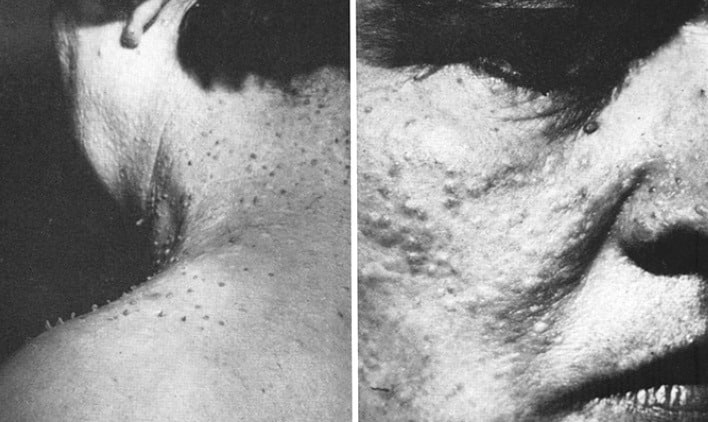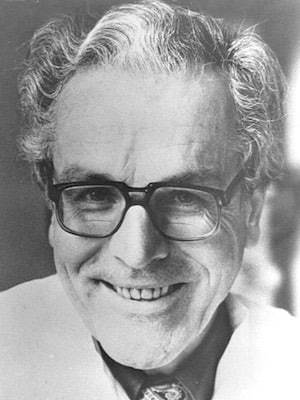Otto P. Hornstein
Otto Paul Hornstein (1926 – 2018) was a German dermatologist.
Prof. Dr. med. Otto P. Hornstein, former director of the dermatology clinic and professor emeritus for dermatology and venereology at the Friedrich-Alexander-Universität Erlangen-Nürnberg.
Prof. Hornstein specialised in histopathology, andrology, occupational dermatoses, diseases of the oral mucosa, rheumatology and gastroenterology. Author and co-author of numerous books and over 600 original articles in scientific journals. Recipient of the Federal Cross of Merit (1993) and Bavarian Order of Merit (1997).
Eponymously remembered for describing in 1975, with Monika Knickenberg, the syndrome of Hornstein-Knickenberg. Unfortunately this condition is more commonly termed Birt-Hogg-Dubé syndrome, despite the concerted efforts of various authors.
Biography
- Born on January 22, 1926 in Munich, Germany
- 1946-1950 Studied medicine in Erlangen, Würzburg and Munich
- 1951 – MD
- 1952-1957 Studied anatomy, pathology and dermatology in Regensburg, Würzburg und Zürich; worked as an assistant at the Universitäts-Hautklinik Würzburg
- 1958 – Specialist in dermatology and venereology; lecturer at the University of Würzburg
- 1959 – Assistant at the Universitäts-Hautklinik in Bonn
- 1962 – Council of Europe Scholarship for Experimental Biology at the University of Uppsala (Sweden)
- 1964 – Senior physician and Associate Professor at the Universitäts-Hautklinik in Düsseldorf
- 1967-1995 Full professor of dermatology and venereology and director of the dermatology clinic at the University of Erlangen-Nuremberg
- 1993 – Bundesverdienstkreuz 1. Klasse [Order of Merit of the Federal Republic of Germany]
- 1995 – Retired
- 1997 – Bayerischer Verdienstorden [Bavarian Order of Merit]
- 2000 – Heavily involved in charitable work following retirement, Hornstein worked as a medical advisor in the organization of a German-Indian medical and charitable aid organization for HIV-positive mothers and pregnant women and their children.
- Died on March 19, 2018 in Uttenreuth, Germany
Medical Eponyms
Hornstein-Knickenberg syndrome (HKS)(1975)
In 1975, Otto Hornstein (1926–2018) and Monika Knickenberg described the syndrome of multiple perifollicular fibromas heralding extracutaneous cancer proneness and being inherited as an autosomal dominant trait.

Hornstein published an article in 1976 highlighting this ‘rare, generalized genodermatosis’ and a further paper in 1976, with Knickenberg and Mörl highlighting that multiple perifollicular fibromas may herald the presence of colonic polyposis.
We are prone to assume that the (irregular ?) association of multiple perifollicular fibromas and colon polyps represents a distinct nosological entity neither identical with Gardner’s syndrome nor with any other known dermo-intestinal syndrome. Thus, perifollicular fibromatosis should alert the dermatologist to consider periodic thorough examination for intestinal polyps the more as they may change into malignant growth.
Hornstein, Knickenberg 1975: 161
Major Publications
- Schuermann H, Hornstein OP, Greither A. Krankheiten der Mundschleimhaut und der Lippen. 1966
- Hornstein OP, Knickenberg M. Zur kenntnis des schimmelpenning-feuerstein-mims-syndroms. Archiv für dermatologische Forschung. 1974; 250: 33–50
- Hornstein OP, Knickenberg M. Perifollicular fibromatosis cutis with polyps of the colon—a cutaneo-intestinal syndrome sui generis. Archives of Dermatological Research. 1975; 253: 161–175 [Hornstein-Knickenberg syndrome]
- Hornstein OP. Generalized dermal perifollicular fibromas with polyps of the colon. Hum Genet. 1976;33(2):193-197. [Hornstein-Knickenberg syndrome]
- Hornstein OP, Knickenberg M, Mörl M. Multiple dermal perifollicular fibromas with polyps of the colon — report of a peculiar clinical syndrome. Acta Hepatogastroenterol (Stuttg). 1976;23(1):53-58. [Hornstein-Knickenberg syndrome]
- Hornstein OP, Bäurle G. Externe Therapie von Hautkrankheiten : pharmazeutische und medizinische Praxis. 1985
- Sigg C, Hornstein OP. Das Spermiozytogramm : Grundlagen u. diagnost. Anwendung in d. Andrologie. 1987
- Hornstein OP. Berufsdermatosen : aktuelle Perspektiven. 1988
- Hornstein OP, Meinhof W. Fortschritte der Mykologie : 150 Jahre nach Johann Lucas Schönlein. 1991
- Hornstein OP. Erkrankungen des Mundes : ein interdisziplinäres Handbuch und Atlas. 1996
Controversies
The autosomal dominant inherited syndromes of Hornstein-Knickenberg (HKS) and Birt-Hogg-Dubé (BHDS) are both characterized clinically by the presence of multiple flesh coloured papules of the skin. Hornstein and Knickenberg termed the peripheral lesions of HKS ‘perifollicular fibromas’ whilst Birt, Hogg and Dubé proposed the name ‘fibrofolliculoma’.
The nosological dilemma is twofold:
- Many authors believe that perifollicular fibromas and fibrofolliculomas are one and the same, and not a reason to suppose that the condition described by Birt, Hogg and Dubé (1977) was a new disorder from that originally described by Hornstein and Knickenberg (1975)
- The importance of ‘extracutaneous cancer proneness’, was postulated in all three papers by Hornstein, but not in the 1977 of Birt, Hogg and Dubé. Numerous authors have corroborated the association between multiple perifollicular fibromas and colonic polyps/cancer as Hornstein and Knickenberg suggested.
Prof Dr Rudolf Happle of the Department of Dermatology, at the University of Freiburg staunchly moved for a name change in 2012, and again in 2020
Birt et al. did neither discover nor describe any new cutaneous disorder heralding proclivity to extracutaneous cancer. Hence, the term ‘Birt-Hogg-Dubé syndrome’ represents a bold distortion of history and should no longer be used to describe the disorder specified by Hornstein and Knickenberg…it is not justified to combine the names of the discoverers of a new genodermatosis heralding extracutaneous cancer proneness with those claiming that they had detected a quite different hereditary skin disorder characterized by ‘fibrofolliculomas’, without any proclivity to extracutaneous cancer…Today, time has come to put this right. The syndrome should be named after the original authors, Hornstein and Knickenberg
Happle 2020
- Schulz T, Hartschuh W. Birt-Hogg-Dubé syndrome and Hornstein-Knickenberg syndrome are the same. Different sectioning technique as the cause of different histology. J Cutan Pathol. 1999; 26(1): 55-61.
- Happle R. Hornstein-Birt-Hogg-Dubé syndrome: a renaming and reconsideration. Am J Med Genet A. 2012;158A(6):1247-1251.
- Happle R. Hornstein–Knickenberg syndrome vs. Birt–Hogg–Dubé syndrome: a critical review of an unjustified designation. Journal of the European Academy of Dermatology and Venereology 2020; 34(4): 885-887
References
- Haneke E, Marsch W. In Memoriam Otto Paul Hornstein 1926 – 2018. J Dtsch Dermatol Ges. 2018;16(7):958-961.
- Bibliography. Hornstein, Otto P. WorldCat Identities

